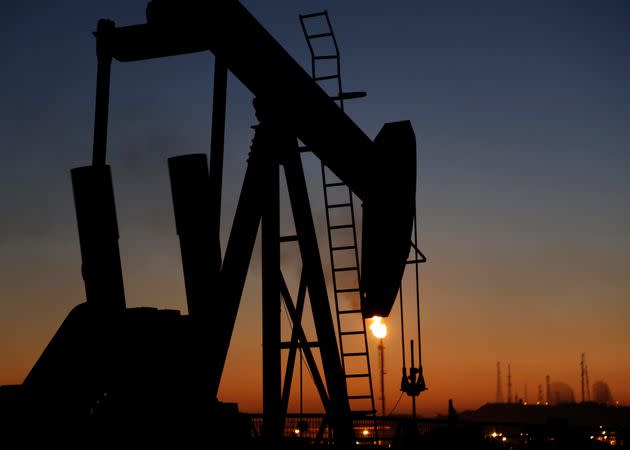Why Gas Prices Are Likely To Spike Again

In this Jan. 18, 2016, file photo, an oil pump works at sunset, in the desert oil fields of Sakhir, Bahrain.
The world’s oil cartel agreed to slash production of crude by nearly 2 million barrels per day starting in January, a move likely to ratchet up geopolitical tensions with the United States and spike energy costs.
At its Thursday meeting, the 13-member Organization of the Petroleum Exporting Countries and its 10 Russia-led allies, which together constitute what’s known as OPEC+, agreed to reduce total output by 1 million barrels per day. Saudi Arabia, the world’s second-largest oil producer, had already said it would cut 1 million barrels per day beginning in 2024.
OPEC+ said the move is aimed at keeping prices high by reducing supply amid fears that demand might fall. Rising crude prices have helped buoy major infrastructure initiatives in countries like Saudi Arabia, and helped Russia skirt Western sanctions on the main export funding its war effort in Ukraine.
By late Thursday morning in the U.S., the price of Brent crude ― the benchmark for oil refined in Western Europe ― climbed by less than 1% to more than $83 per barrel. Murban crude — the benchmark for oil shipped from the United Arab Emirates — surged by more than 1% to nearly $85 per barrel.
The price of a barrel of West Texas Intermediate ― the benchmark for U.S. oil ― fell by more than 1% to just under $77. The drop came after the federal Energy Information Administration pegged its latest estimates of U.S. crude supplies at 1.6 million barrels above the previous week.
In the days before the Thanksgiving holiday, the price per gallon of gasoline — which is made from refined oil — averaged $3.24 across the U.S., 26 cents less than a month ago and 40 cents less than a year ago, according to AAA data.
But the production cuts announced on Thursday are expected to send oil prices surging between $90 and $100 per barrel over the next month, according to an analyst note from UBS Global Wealth Management.
Higher oil prices could take a political toll on President Joe Biden, whose energy policies Republican opponents have blamed for rising fuel costs despite the Democrat overseeing record production of oil and gas.
The effect on the U.S. public’s support for policies to shift to cleaner energy sources could be muted. On the one hand, some may buy into the argument that the federal government’s generous tax credits for renewable energy are in some way responsible for oil and gas prices. On the other, a higher cost at the pump or increased heating bills might make an electric vehicle or a heat pump look more attractive, particularly in states where electricity prices are already low.
The OPEC+ decision came right as global diplomats and advocates arrived in Dubai for the latest United Nations climate summit.
When OPEC+ made similar cuts in the fall of 2022, the U.S. sharply criticized the move as a “shortsighted decision” designed to boost Russia’s war effort. Thursday’s move comes amid growing tensions over the war between Israel and Hamas in Gaza.
The cartel curtailed oil exports to the U.S. and Europe in the 1970s over the West’s support for Israel as the Jewish state battled neighboring Arab countries’ armies. Oil prices spiked last month as Israel prepared to invade Gaza after the Hamas militants who control the coastal Palestinian enclave launched the deadliest attack on Jewish civilians since the Holocaust.
But signs that other regional powers like Iran would not directly join the conflict, and an uptick in oil supplies in the U.S. — which, unlike half a century ago, is now the world’s No. 1 producer ahead of Saudi Arabia — eased investors’ fears, sending prices back down.
While Saudi Arabia and Russia had already agreed to slash drilling in September, producers such as the United Arab Emirates, Angola and Nigeria resisted calls to reduce output, according to The Wall Street Journal, which first reported Thursday’s deal to cut production.
In an unusual step, OPEC+ members planned to announce production cuts on an individual basis rather than as a group, which analysts said had likely muted the market response for now.
“The market is going to test Opec+ and whether $80 a barrel is really a floor they can defend,” Raad Alkadiri of Eurasia Group told the Financial Times. “The cuts being billed as ‘voluntary’ undermines the psychological impact for the market a little, but if the full cut is realised, its impact on the market should not be discounted.”
